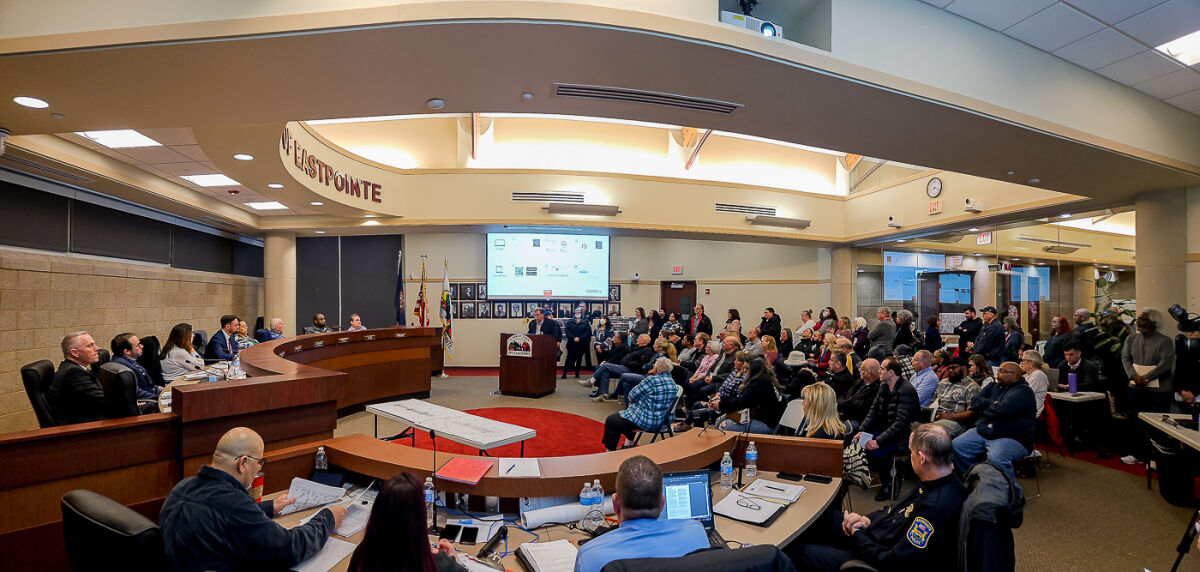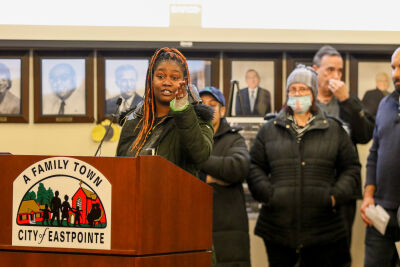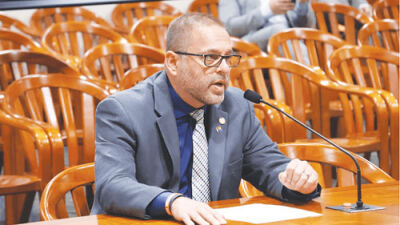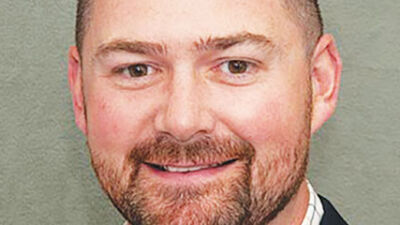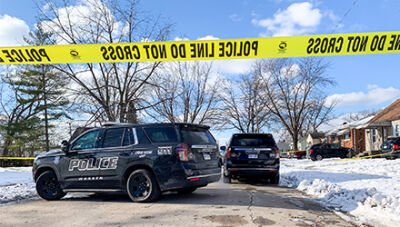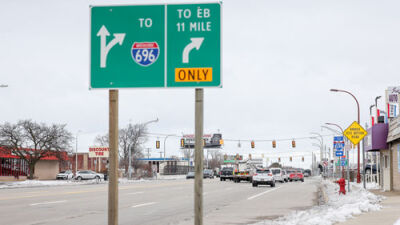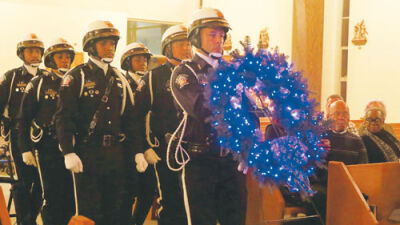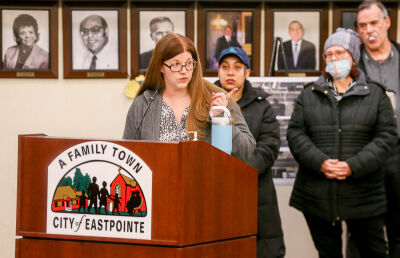
Dianna Urness-Jones is against the road diet and believes the three-lane conversion will make people avoid driving on Nine Mile Road.

“I think a lane reduction makes our community safer,” said Eastpointe Mayor Michael Klinefelt, who voted in favor of the road diet.
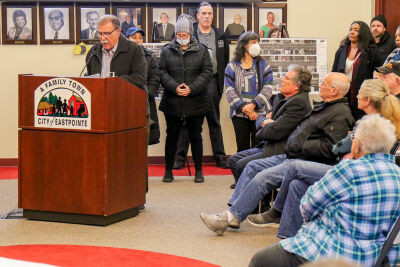
Frank Fazi, who owns property along Nine Mile Road, talks about the parking issues that will result from going from five to three lanes.
EASTPOINTE — A section of Nine Mile Road between Kelly Road and Gratiot Avenue will undergo a transformation.
At the Feb. 6 City Council meeting, the council voted 3-2 on a “road diet,” which will transform Nine Mile Road from Pleasant Avenue to Tuscany Avenue from five lanes to three lanes. A “road diet” is basically the shrinking of the road. Going from five to three lanes is intended to make the city more walkable downtown to attract more businesses and more people walking to those businesses. It will create additional green space, and supporters feel it will make the road safer.
Nine Mile Road currently has five lanes of traffic, two going eastbound, two going westbound and a center turning lane. The road diet from Pleasant to Tuscany will result in three lanes of traffic: one eastbound, one westbound and a center turning lane.
Mayor Michael Klinefelt, Mayor Pro Tem Cardi DeMonaco Jr. and Council member Margaret Podsiadlik voted in favor of the motion. Council members Rob Baker and Harvey Curley voted against the project, wanting the section of the road to stay five lanes.
The conversion is part of the Modern Nine Main Street Project that began last year in the city. The project, to be completed in three phases, will include a new road, the installation of a new water main system and a new main gas line. Now that council has approved the road diet for phase two, the design will be submitted to the Michigan Department of Transportation to go forward with the project.
“I think a lane reduction makes our community safer,” Klinefelt said. “The data we’ve been given shows (traffic) will be safer.”
“Why not try something new and see what we can do on Nine Mile?” DeMonaco Jr. said. “As people have said, there’s a lot of vacant businesses and no reason to walk Nine Mile. Why don’t we make a reason to walk Nine Mile and make it our own little downtown?”
The cost of the road reduction is “just over” $5.2 million, according to Ryan Kern, senior project engineer with Anderson, Eckstein and Westrick Inc., the city’s engineering firm, which is based in Shelby Township.
“That’s not to say that that is what the bids are going to come in. They could come in higher or lower,” Kern said. “With the removal of the pavement, you have a lot of vegetation that needs to be done. You still have an embankment that needs to be placed. The drive approaches and the storm sewers have to be extended. There’s additional sidewalk and handicapped work involved in that too, as well as the bus lanes that need to be added.”
He said that 81.85% of the construction is being paid for with federal funding.
“The 18.15% match is being covered by the ACT 51 funds the city receives from the state through the gas tax,” Kern said. “But all the costs involved with design and the redesign, construction inspection, surveying, would be 100% funded through the city through the gas tax.”
Kern said the costs do not include streetscape or tree placement.
“It would have to be done under a separate project,” Kern said. “We did not consider bike lanes. We did not consider including additional crosswalks, but that’s something that can be added as well.”
Public safety concerns
The city’s Police Department, 16083 E. Nine Mile Road, is located at the northeastern corner of Nine Mile and Gratiot Avenue. The Fire Department is located at 16370 E. Nine Mile Road right at Pleasant Avenue. Neither Police Chief Corey Haines nor Fire Chief Brian Marquardt — both present at the meeting — support the three-lane conversion.
“We are going to need all five lanes to back our ladder truck back into there and also to make turns going out of our station to go either left or right with that ladder truck, because the bucket will swing out so far,” Marquardt said.
He added that earlier in the day he and other staff saw a traffic backup between the Dollar General store and Pleasant Avenue.
“It was packed because traffic backed up going eastbound, so people got stuck at that light,” he said. “We would have not been able to get out. If the council decides to do this, as the fire chief, I cannot support this because of delays.”
Access to fire hydrants is another concern should certain streets be blocked off with the conversion.
“That’s also going to possibly make the hydrants unusable on Nine Mile,” Marquardt said. “We’ll have to add hydrants on the side streets because the road will be blocked.”
Haines also shared his perspective.
“Nine Mile is our thoroughfare. Nine Mile is what we use to get everywhere in this city to protect people and to give them the service that we have promised to give them,” Haines said. “Shortening Nine Mile down to three lanes is going to cause issues, I promise you that. I’ve talked to these officers, I’ve talked to my command staff. We all agree it’s not the right thing to do for safety.”
Many residents, business owners oppose road diet; a handful say they like it
The 3-2 vote was unpopular with many residents and business owners, who voiced their opposition at the hearing of the public held before the council voted. They are concerned about safety issues, traffic congestion, speeding, residential streets possibly being blocked off at Nine Mile, and a loss in business clientele because people will avoid Nine Mile. Police and fire getting to emergencies also is a worry.
Some residents suggested that instead of using the funds for the road change, city officials should use it to repair the road and sidewalks and update the city’s parks. Because so many people turned out for the meeting, there was not enough room in the council chambers to fit everyone, so some sat in the atrium of City Hall.
Ken Hoffman, who lives on Melrose Avenue west of the fire station, called the road diet “stupid” and “a wasted idea.”
“I cannot understand why anyone would suggest having (St. Clair) Shores five lanes and Warren five lanes and then cut down into two here in Eastpointe,” Hoffman said.
Venus Earles, a mother of two young children, said she is opposed to the three-lane conversion. She compared it to the current construction on Nine Mile, in which just three lanes are currently open.
“It is so backed up and so many of the side streets are backed up because people are avoiding it,” Earles said. “If you’re trying to go to Kelly (Road), let’s talk about Popeyes Chicken; sometimes people are out in the street blocking that lane completely. I’m just not understanding how people are thinking this will be better for business and better for the flow of traffic.”
David DeRonne, who owns the family business DeRonne Hardware and Rental at 18561 Nine Mile Road, doesn’t see “the rationale” behind the road diet.
“I’m curious if there is any statistics or anything that can show where a lane restriction like this helped improve the businesses in the area,” DeRonne said. “We certainly don’t see it as an improvement for the businesses in the area here. It’s difficult for people to pull out onto Nine Mile now with five lanes. There’s going to be a parade of traffic coming by, and they’re not going to have a chance to get onto Nine Mile.”
“The Nine Mile Project, it’s basically aesthetic to make things look more pleasing. However, this is a safety issue. Our Fire Department, our Police Department, they’re both on Nine Mile. They don’t really have any other way in or out,” resident Karen Mouradjian said. “Eastpointe is not set up like Ferndale or Royal Oak or Birmingham or any of the other suburbs where they have a thriving downtown area. You would have to reduce the speed limit down to 25. Our city is already walkable enough. You can walk to whatever business you want.”
There were a handful of residents who said the road conversion is a good move for the city. Tim Kniaz shared research he did on the success of road diets.
“Since the 1970s when we first did road diets, there has been a litany of proof that road diets work for bringing in new business, life to old businesses, has ecological benefits and walkability will come because you’re bringing in new businesses,” Kniaz said. “Nine Mile currently has nothing for you to go to. That’s because it’s a five-lane hellhole. Nobody wants to walk down Nine Mile. Nobody wants to put businesses there. There are a lot of people in this community against progress.”
Heather Zielinski, of Autism Society of Greater Detroit, offered her thoughts.
“Every city is looking for areas that are walkable. That walkability brings in those businesses that pay the taxes that fund the schools,” Zielinski said. “I want to speak on behalf of the community that I support. Projects like this, if you turn them down, will disadvantage greatly the disabled population. Being able to provide them a path will be that soapbox that Eastpointe can stand on about making things accessible for everyone.”
Steven Hammontree, who attended the public hearing with his mom, Dawn Hammontree, said he was “mixed” on the issue.
“I support the idea of a road diet, of slowing down traffic and making it harder for drivers to speed and be negligent, but I don’t like the plans that are in front of us,” said Hammontree, who often bikes in the city. “Those do not feel like they will increase safety to me. You could add bike lanes. The city has none of those. You could add street parking if space is made available. I want a safer Nine Mile Road; I don’t think we quite have the right way to do it here.”
Before a start date can be confirmed, MDOT must approve the project and then solicit bids to select a contractor.
 Publication select ▼
Publication select ▼